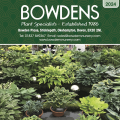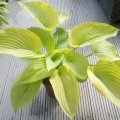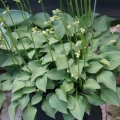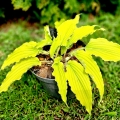Online Shop
128
Royal Horticultural Society
Gold Medals
Royal Horticultural Society
Gold Medals
- Home
- Other Plants
- Stumperies
Stumperies
Bowdens have a wide selection of logs and stumps available here. Or call us for us to discuss your choice of stumps on 01837 849367.
Creating Your Own Stumpery
Location
A stumpery is useful under trees or hedges, dank corners or to hide an eyesore; areas where there is a lot of shade and very few plants will grow. Rather than being ignored the area can be turned into picturesque woodland setting bringing the wild into the garden. Interplant with ferns and other shade loving plants and bulbs, give it time to establish, and it will soon be a talking point in the garden.
The added benefit of a stumpery apart from low maintenance is that it can become a haven for birds, bugs and insects and given the right conditions even small mammals such as hedgehogs and shrews or reptiles such as toads and lizards. Create a living wood sculpture and eco system in your very own backyard.
Design
Stumpery creation involves replicating a forest floor using a mix of different sized wood stumps and logs. Oak, sweet chestnut and beech are the best woods as they rot slowly, but other hardwoods will do. Far from being random, positioning should be contrived to make best use of the different shapes and intricate root structures of the wood. Stumps can be positioned on their sides, upside down or right side up, exposing the most interesting structures and root system. Gnarled and twisted shapes work well to create form and shape.
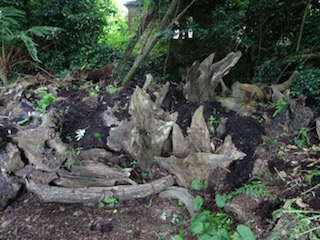
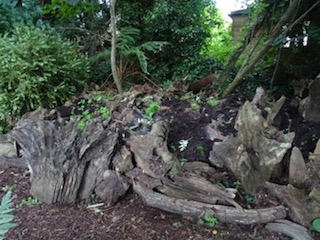
Don’t build on compacted soil. Prepare the ground beforehand digging and forking it over to a depth of at least 20cm. Incorporate plenty of leaf mould or compost. Position stumps first; groups of stumps placed close together as well as individual ones look natural. Arrange for aesthetic appeal and when happy with the overall effect, sink the larger stumps into the ground for stability. Be patient as this may take several attempts before the desired effect is achieved.
Place logs in spaces between stumps. Small logs can be placed in a square, criss-crossed or interlocking to make the stumpery more interesting, and contain ferns within. Pieces of branches sticking out make ideal perches for birds. A useful tip is to position logs at the front to create a border at the edge, framing the stumpery and dividing it from a formal garden setting or path.
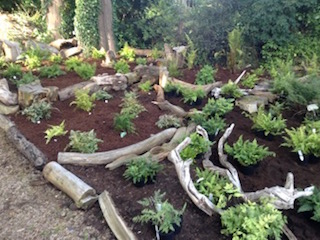
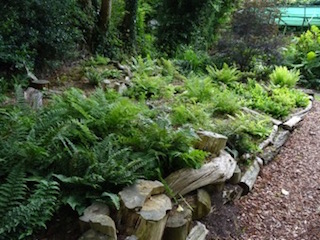
Spaces between stumps and logs can then be infilled with compost. Allow the whole area to settle down before planting. Leave space at the back of the stumpery for group planting of taller plants.
Use the crevices and niches that form pocket holes in stumps or logs. If you line the hole with moss it will retain moisture. Add compost to the hole and then plant the fern rootstock directly in the hole on top of the compost. Incorporate more compost around the root.
Important: Do not bury the crown of the fern when planting otherwise rot may set in – the crown should be proud of the soil it is being planted in.
More moss can be added around the crown and over the roots to act as a plug. Keep the plants in the stump or log watered thoroughly.
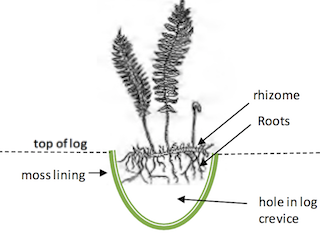
Finally apply a 5cm deep layer of bark chips or mulch to keep down weeds and conserve moisture. In woodland, leaf litter would carpet the floor acting as a natural weed suppressant. The bark or mulch also unites the whole look of the area.
Hot tip: Enourage mosses and lichens to develop on logs and stumps by smearing them with yogurt.
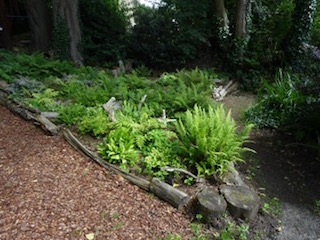
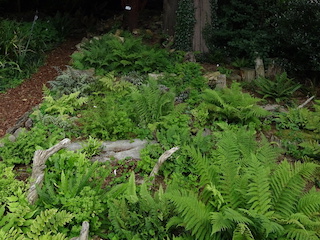
If you have a small back garden or area and don’t think you have the space, then create a mini stumpery using just a few stumps or arrange different sized logs in a pile. Even a paved or gravel area can be transformed with a few stumps and logs with potted plants interspersed between. Also make use of the pocket holes in stumps or logs for planting.
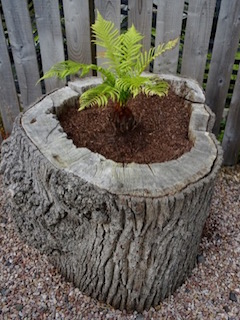
Tree Stump Planter
Ferns are an obvious choice for a stumpery in very deep or semi shade areas, and being shallow rooting can be planted in stumps and logs as well as open ground. Bowdens has an extensive range of over 200 ferns suitable for dry, wet or boggy conditions, that not only mature to different sizes, but are evergreen, wintergreen or deciduous. Because they have such varied texture and structure, ferns can be planted alone or complimented by clumps of woodland plants such as foxglove, native blue bells, wood and Japanese anemones, dwarf narcissi, snowdrops, cowslip, primrose, campanulas not forgetting hostas!
For a more ambitious stumpery where space allows, plant a tree fern. Dicksonia antarctica is the hardiest tree fern, hardy to -12ºC. They just require a sheltered position out of strong wind.
Need inspiration? Visit the evolving stumpery in Bowdens' National Hosta Collection in Sticklepath. Also see the article on our website: In this Island Woodland, Stumped is not a Bad Thing.
Bowdens sells logs and stumps – please call for details on 01837 849367.
Location
A stumpery is useful under trees or hedges, dank corners or to hide an eyesore; areas where there is a lot of shade and very few plants will grow. Rather than being ignored the area can be turned into picturesque woodland setting bringing the wild into the garden. Interplant with ferns and other shade loving plants and bulbs, give it time to establish, and it will soon be a talking point in the garden.
The added benefit of a stumpery apart from low maintenance is that it can become a haven for birds, bugs and insects and given the right conditions even small mammals such as hedgehogs and shrews or reptiles such as toads and lizards. Create a living wood sculpture and eco system in your very own backyard.
Design
Stumpery creation involves replicating a forest floor using a mix of different sized wood stumps and logs. Oak, sweet chestnut and beech are the best woods as they rot slowly, but other hardwoods will do. Far from being random, positioning should be contrived to make best use of the different shapes and intricate root structures of the wood. Stumps can be positioned on their sides, upside down or right side up, exposing the most interesting structures and root system. Gnarled and twisted shapes work well to create form and shape.


Don’t build on compacted soil. Prepare the ground beforehand digging and forking it over to a depth of at least 20cm. Incorporate plenty of leaf mould or compost. Position stumps first; groups of stumps placed close together as well as individual ones look natural. Arrange for aesthetic appeal and when happy with the overall effect, sink the larger stumps into the ground for stability. Be patient as this may take several attempts before the desired effect is achieved.
Place logs in spaces between stumps. Small logs can be placed in a square, criss-crossed or interlocking to make the stumpery more interesting, and contain ferns within. Pieces of branches sticking out make ideal perches for birds. A useful tip is to position logs at the front to create a border at the edge, framing the stumpery and dividing it from a formal garden setting or path.


Spaces between stumps and logs can then be infilled with compost. Allow the whole area to settle down before planting. Leave space at the back of the stumpery for group planting of taller plants.
Use the crevices and niches that form pocket holes in stumps or logs. If you line the hole with moss it will retain moisture. Add compost to the hole and then plant the fern rootstock directly in the hole on top of the compost. Incorporate more compost around the root.
Important: Do not bury the crown of the fern when planting otherwise rot may set in – the crown should be proud of the soil it is being planted in.
More moss can be added around the crown and over the roots to act as a plug. Keep the plants in the stump or log watered thoroughly.

Finally apply a 5cm deep layer of bark chips or mulch to keep down weeds and conserve moisture. In woodland, leaf litter would carpet the floor acting as a natural weed suppressant. The bark or mulch also unites the whole look of the area.
Hot tip: Enourage mosses and lichens to develop on logs and stumps by smearing them with yogurt.

If you have a small back garden or area and don’t think you have the space, then create a mini stumpery using just a few stumps or arrange different sized logs in a pile. Even a paved or gravel area can be transformed with a few stumps and logs with potted plants interspersed between. Also make use of the pocket holes in stumps or logs for planting.

Tree Stump Planter
- Hollow out the centre with a mattock (wear safety glasses). Leave around 5-10cm around the edge unless a smaller planting is desired.
- Ferns are shallow rooting so depth does not need to be too deep, 15cm is sufficient
- Drill a few holes in the bottom at an angle for drainage, to prevent water saturation and root rot.
- To improve drainage and prevent the holes clogging, place gravel as a bottom layer covering the holes.
- Infill the planter with compost.
Ferns are an obvious choice for a stumpery in very deep or semi shade areas, and being shallow rooting can be planted in stumps and logs as well as open ground. Bowdens has an extensive range of over 200 ferns suitable for dry, wet or boggy conditions, that not only mature to different sizes, but are evergreen, wintergreen or deciduous. Because they have such varied texture and structure, ferns can be planted alone or complimented by clumps of woodland plants such as foxglove, native blue bells, wood and Japanese anemones, dwarf narcissi, snowdrops, cowslip, primrose, campanulas not forgetting hostas!
For a more ambitious stumpery where space allows, plant a tree fern. Dicksonia antarctica is the hardiest tree fern, hardy to -12ºC. They just require a sheltered position out of strong wind.
Need inspiration? Visit the evolving stumpery in Bowdens' National Hosta Collection in Sticklepath. Also see the article on our website: In this Island Woodland, Stumped is not a Bad Thing.
Bowdens sells logs and stumps – please call for details on 01837 849367.
New Additions
-
Bowdens 2024 Catalogue £0.00

-
Wundergold £15.00

-
venusta 'Porter' £8.00

-
Valley's Love Birds £14.00

-
Valley's Lemon Squash £14.00

